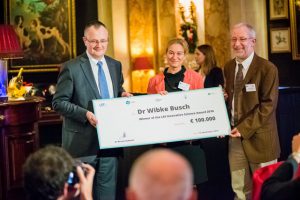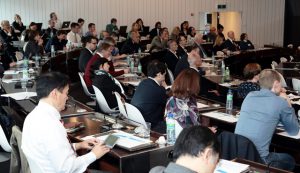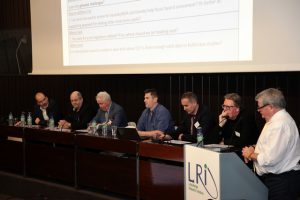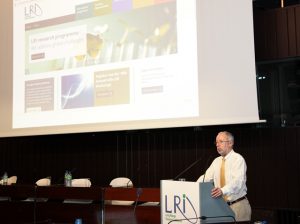The Long-Range Research Initiative Programme (LRI) of the European Chemical Industry Council (Cefic) organised its Annual Workshop on 16 and 17 November 2016 in Brussels. The 18th edition of the workshop focused on “AOPs (Adverse Outcome Pathways) and Genomics: how useful, how to address risk, and where next?”, and showcased results of LRI projects completed in 2015-2016 in the areas of environmental methodology of mixtures and residues, grouping of nanomaterials, dust and workers exposure, dermal absorption modelling, eye irritation alternatives, epidemiological evidence of endocrine disruption, and epigenetics normality.
At a gala dinner on 16 November the 2016 LRI Innovative Science Award was presented to Dr Wibke Busch of the Helmholtz Centre for Environmental Research in Germany. Dr Busch’s project concept: “Genome wide profiling of molecular responses related to toxicokinetic and toxicodynamic processes for the determination of key events as basis for quantitative AOPs” could help establish a quantitative link between molecular effects and adverse outcome, identify key responses and key event sequences within AOPs, and provide an experimental approach for a systematic development of advanced predictive models.
Read the full article on the LRI Innovative Science award 2016 here.
Video from the LRI Award Ceremony
On the morning of 17 November nine completed LRI projects were presented. Many of the projects will be contributing new tools to the LRI Toolbox and all project results are available via the LRI website.
The morning session was completed by an overview of the outcomes of the ICCA-LRI and Japanese National Institute of Health Sciences (NIHS) workshop held in June. The meeting addressed global challenges in applying new scientific methods to improve environmental and human health risk assessments. The meeting concluded that increased global interaction and cooperation is required and a shift away from traditional toxicity testing towards new technologies for data collection, analysis, and interpretation is required.
In the afternoon the workshop focused on a significant panel discussion on the utility of and progress in AOPs and Genomics. There was a general consensus that AOPs give us a structure for understanding and brings learning together, however quantitative aspects that provide the potential for predictive outcomes requires more work. ‘Omics’ and AOPs can be used to understand biological activity of molecules that are not designed to be bioactive and provide an effective screening approach that could define a zone of safe exposure. In particular it was important to “test drive an AOP and learn from doing” identifying current gaps in our knowledge and also identifying researchers in other fields that can also contribute to progress in this area.
Dr Bruno Hubesch, LRI Programme Consultant (Research & Innovation, Cefic) closed the workshop mentioning that there was a tendency in LRI projects to focus on regulatory aspects, while companies require screening level models to assess new products at before market entry or the regulatory aspect.
For more information on our LRI workshop, please consult the final report of the event here.
Plenary Presentations:
Welcome / short outline
Dr Stuart Marshall, Unilever, Chair Cefic LRI Strategy Implementation Group
ECO23 – TIPTOP: Combining passive sampling and toxicity profiling to assess mixture toxicity of surface waters
Dr Timo Hamers, VU Amsterdam, NL
ECO24 – Prediction of Non-Extractable Residues using structural information (‘structural alerts’)
Dr Ralph Kuhne, Umwelt Forschung Zentrum Leipzig, DE
N4 – Grouping nanomaterials and establishing criteria for Safe by Design
Dr Hans Bouwmeester, Wageningen University, NL
AIMT6 – CON4EI: CONsortium for in vitro Eye Irritation testing strategy
Dr An Van Rompay, VITO, BE
B12 – DustEx: How relevant is the dust pathway for consumer exposure to SVOCs?
Dr Natalie von Goetz, ETH Zurich, CH
B13 – Development of a mechanistic in silico multi-scale framework to assess dermal absorption of chemicals
Dr Rebecca Notman, University of Warwick, UK
B16 – External validation of Tier-1 workers dermal exposure estimates in ECETOC TRA
Dr Wouter Fransman, TNO, NL
EMSG58 – Quality assessment of the epidemiological evidence of adverse effects to humans of endocrine active substances in the environment
Prof Carlo La Vecchia, University of Milan/Mario Negri Institute, IT
C3 – Epigenetics: Normality in Toxicologically Relevant Species, Development of a framework to better understand the impact of epigenetics on (eco)toxicology
Prof Richard Meehan, University of Edinburgh, UK
Global challenges on Awaji Island
Dr Alan Poole, ECETOC, BE
Set the stage talk 1: Genomics technology
Prof Jos Kleinjans, Maastricht Univ, NL
Set the stage talk 2: AOPs methodology
Prof Aldert Piersma, RIVM, NL
The links to the invited posters are below:

















